TWP:
TWA:
Saturday, December 30, 2017
Tuesday, November 21, 2017
ELEC board
The ELEC board has been designed to fit the ELEC panel of the F16.
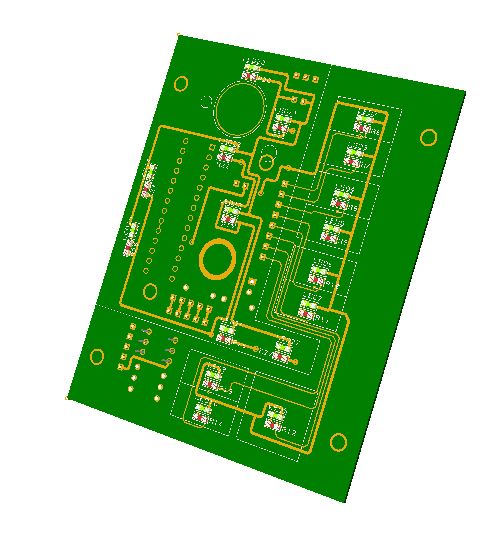
The board comes with the following elements:
- (1) 16 I/O chip to be connected to the digital I/O I2C channel of the PSCockpit system and its elements (resistors, connectors, …) to work with 5V.
- (1) 3-positions switch with locking lever.
- (1) pushbutton.
- (9) SMD leds for indicators.
- (8 ) SMD leds for lettering backlight.
- (4) free I/O’s.
You will find the following elements in the backside:
- (1) Connector for backlight illumination.
- (1) Connectors for digital I/O I2C channel.
- (1) Mini-switch to select digital I2C channel address
- (1) Connector for 4 free digital I/O’s of the 16 I/O chip.
The board can be easily cut to use it with your own indicators using the existing inner connector for this purpose. If the indicators use another voltage than 5VDC you can attach the IO Enhancement pcb to light them.
To complete the ELEC panel, you must add by yourself the front panel, indicator caps and some separator to avoid the light going to other indicators.
Please check the dimensions of the ELEC front panel at:
http://www.mediafire.com/file/hqc9p4df4c27hf8/ELEC-A3.pdf
Regards,
Shep

The board comes with the following elements:
- (1) 16 I/O chip to be connected to the digital I/O I2C channel of the PSCockpit system and its elements (resistors, connectors, …) to work with 5V.
- (1) 3-positions switch with locking lever.
- (1) pushbutton.
- (9) SMD leds for indicators.
- (8 ) SMD leds for lettering backlight.
- (4) free I/O’s.
You will find the following elements in the backside:
- (1) Connector for backlight illumination.
- (1) Connectors for digital I/O I2C channel.
- (1) Mini-switch to select digital I2C channel address
- (1) Connector for 4 free digital I/O’s of the 16 I/O chip.
The board can be easily cut to use it with your own indicators using the existing inner connector for this purpose. If the indicators use another voltage than 5VDC you can attach the IO Enhancement pcb to light them.
To complete the ELEC panel, you must add by yourself the front panel, indicator caps and some separator to avoid the light going to other indicators.
Please check the dimensions of the ELEC front panel at:
http://www.mediafire.com/file/hqc9p4df4c27hf8/ELEC-A3.pdf
Regards,
Shep
Sunday, November 19, 2017
AUDIO1 and AUDIO2 board
The AUDIO board has been designed to fit the AUDIO1 and AUDIO2 panels of the F16 in only one board. The spacing between AUDIO1 part and AUDIO2 part is 2 mm. If you have other spacing than 2 mm between your AUDIO1 and AUDIO2 panels, the board can be cut in two and the signals between them must be wired using the existing connectors for this purpose.
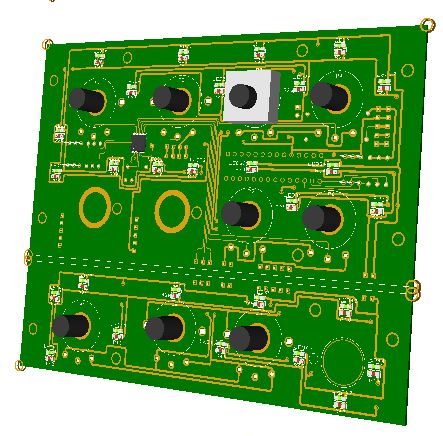
The board comes with the following elements:
- (1) 16 I/O chip to be connected to the digital I/O I2C channel of the PSCockpit system and its elements (resistors, connectors, …) to work with 5V
- (1) analogue chip to be connected to the Main Channel of the PSCockpit system and its elements (resistors, connectors, …) to work with 5V
- (4) potentiometers with ON/OFF switch
- (4) potentiometers
- (1) encoder
- (2) rotary switches
- (1) 3 position 12mm switch
- (27) SMD leds for lettering backlight.
The board has no free I/O’s.
You will find the following elements in the backside:
- (1) Connector for backlight illumination.
- (1) Connectors for digital I/O I2C channel.
- (1) Connectors for analogue Main Channel.
- (2) Mini-switch to select digital and analogue I2C channel addresses
To complete the AUDIO panel, you must add by yourself the front panel and knobs.
Be aware that this AUDIO panel does not fit perfectly the HISPAPANEL Audio1 and Audio2 panels. Some of the holes must be reworked although there is room in the board to do it without damaging any track.
Please check the dimensions of the AUDIO1 and AUDIO2 front panels at:
http://www.mediafire.com/file/sbzj6q4bb8j14x9/AUDIO1and2Panel-A3.pdf
Regards,
Shep

The board comes with the following elements:
- (1) 16 I/O chip to be connected to the digital I/O I2C channel of the PSCockpit system and its elements (resistors, connectors, …) to work with 5V
- (1) analogue chip to be connected to the Main Channel of the PSCockpit system and its elements (resistors, connectors, …) to work with 5V
- (4) potentiometers with ON/OFF switch
- (4) potentiometers
- (1) encoder
- (2) rotary switches
- (1) 3 position 12mm switch
- (27) SMD leds for lettering backlight.
The board has no free I/O’s.
You will find the following elements in the backside:
- (1) Connector for backlight illumination.
- (1) Connectors for digital I/O I2C channel.
- (1) Connectors for analogue Main Channel.
- (2) Mini-switch to select digital and analogue I2C channel addresses
To complete the AUDIO panel, you must add by yourself the front panel and knobs.
Be aware that this AUDIO panel does not fit perfectly the HISPAPANEL Audio1 and Audio2 panels. Some of the holes must be reworked although there is room in the board to do it without damaging any track.
Please check the dimensions of the AUDIO1 and AUDIO2 front panels at:
http://www.mediafire.com/file/sbzj6q4bb8j14x9/AUDIO1and2Panel-A3.pdf
Regards,
Shep
Backlighting Leds PWM board
The PWM board has been designed to dim backlights leds of the PSCockpit panels and can be used for instrument backlights as well. The board is only 74x18mm and comes with a potentiometer with a switch to turn on/off and dim backlight leds. You can easily mount the board with the potentiometer nut to your Lighting panel and connect the wires at the bottom of the board.
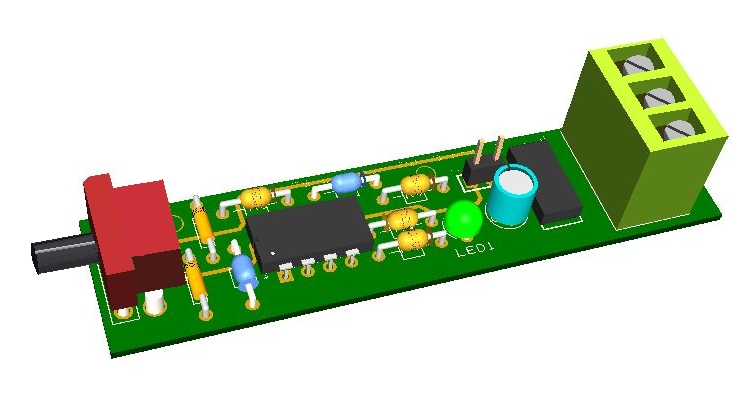
The nominal current for this board is 4Amps and it works in a range of voltage of 5VDC to 12VDC. The current of 4Amps allows to manage up to 200 led sets of 20mA.
Be aware that pulse width modulation can cause interference with other electronic devices. To avoid this undesired situation, use shielded cables and run the cable separately from other signal wires.
The PWM is a standalone board and it has no connection to PSCockpit software.
Regards,
Shep

The nominal current for this board is 4Amps and it works in a range of voltage of 5VDC to 12VDC. The current of 4Amps allows to manage up to 200 led sets of 20mA.
Be aware that pulse width modulation can cause interference with other electronic devices. To avoid this undesired situation, use shielded cables and run the cable separately from other signal wires.
The PWM is a standalone board and it has no connection to PSCockpit software.
Regards,
Shep
Tuesday, November 14, 2017
PSCockpit System 7th Run!!!
Time to launch a new run of the PSCockpit System!!
New boards for this run:
- PWM board for backlights
- ELEC board
- AUDIO1 and AUDIO2 board
More info about above boards to follow.
Version 1.0.3 of the PSCockpit software with vJoy implementation for analogue and DX buttons:
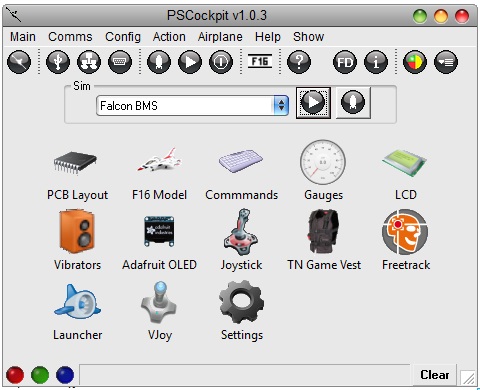
System Description
- One stop hardware and software for cockpit systems. Once the cockpit is connected you can configure the software individually for each sim.
- Easy configuration and setup for people without electronic knowledge.
- Avoid excessive wiring runs along the cockpit.
The system uses small satellite PCB’s that can be distributed along the cockpit. The communication between these satellite PCB’s and the Main PCB is done with only 2 wires (I2C protocol) plus the power cables. These wires can be connected in daisy chain. The idea is to wire each of the cockpit panels to only one satellite PCB. See F16 distribution example:
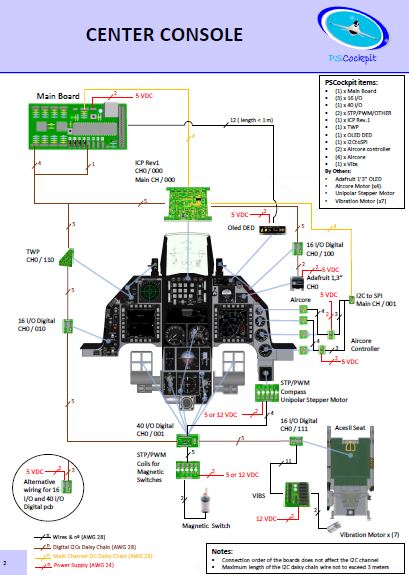
You can download at: http://psfalcon.blogspot.com.es/2016/12/ps-cockpit-system-f16-distribution-file.html
Supported devices
- Digital inputs: Pushbuttons, 2 position switches, 3 position switches, digital encoders, BCD encoding (8 to 3, 16 to 4, 32 to 5) and 8x4 matrixes
- Digital outputs and leds
- Analogue inputs and outputs
- Vibration motors
- Aircores motors
- Stepper motors: Unipolar, X27 and X40
- RC Servomotors
- Segment Displays: 7 segments and SLG2016
- LCD displays: SSD1322 Graphic display 264x64, KS0108 Graphic display 128 x 64, KS0108B Text display 20x4, SSD1306 Adafruit 128x64 (ID938 and ID931)

More information, downloads and guides at http://psfalcon.blogspot.com.es/2015/05/pscockpit-system-up-to-date-software.html
Prices
The prices of the PCB’s already mounted and tested are the following:
- Main PCB: 60 €
- Digital expander for 40 inputs/outputs: 33 €
- Digital expander 16 inputs/outputs: 10 €
- Steppers/Other voltage outputs pcb: 28 €
- 7 segment displays pcb for 6 displays: 18 €
- Analogue pcb for 4 inputs/ 1 output: 20 €
- Yellow OLED display (85mm x 40mm), 256x64 for DED or PFL: 55 €
- I2CtoSPI pcb: 25€
- Aircore Controller pcb: 24€
- Aircore pcb: 15€
- Vibration motors pcb: 38€
- I/O Enhancement pcb: 6,5€
- Caution Panel board: 40€
- UHF board: 90€
- ICP pcb Rev 1: 90€
- CMDS board (with 2 rotary switches 30º & 45º, no toggles, no displays): 80€
- CMDS options:
- Miniature toggles 6 mm diam. (1 with locking lever): 40€
- SGL2016 displays: 35€ (each)
- HDLG-1414 displays: 20€ (each)
- 7 segment displays pcb with 8 displays: 35€
- TWP board: 40€
- TWA board: 20€
- X40 stepper board: 20€
NEW BOARDS:
- PWM board: 20€
- ELEC board: 50€
- AUDIO1 & AUDIO2 board: 100€
- Shipment: 15€ / 25€ depending on the total weight order
Time Line:
- Orders will be accepted until Dec. 17th.
- Only direct bank transfers for payments. Sorry for the inconvenience.
- Delivery: Starting February 2017
Regards,
Shep
New boards for this run:
- PWM board for backlights
- ELEC board
- AUDIO1 and AUDIO2 board
More info about above boards to follow.
Version 1.0.3 of the PSCockpit software with vJoy implementation for analogue and DX buttons:

System Description
- One stop hardware and software for cockpit systems. Once the cockpit is connected you can configure the software individually for each sim.
- Easy configuration and setup for people without electronic knowledge.
- Avoid excessive wiring runs along the cockpit.
The system uses small satellite PCB’s that can be distributed along the cockpit. The communication between these satellite PCB’s and the Main PCB is done with only 2 wires (I2C protocol) plus the power cables. These wires can be connected in daisy chain. The idea is to wire each of the cockpit panels to only one satellite PCB. See F16 distribution example:

You can download at: http://psfalcon.blogspot.com.es/2016/12/ps-cockpit-system-f16-distribution-file.html
Supported devices
- Digital inputs: Pushbuttons, 2 position switches, 3 position switches, digital encoders, BCD encoding (8 to 3, 16 to 4, 32 to 5) and 8x4 matrixes
- Digital outputs and leds
- Analogue inputs and outputs
- Vibration motors
- Aircores motors
- Stepper motors: Unipolar, X27 and X40
- RC Servomotors
- Segment Displays: 7 segments and SLG2016
- LCD displays: SSD1322 Graphic display 264x64, KS0108 Graphic display 128 x 64, KS0108B Text display 20x4, SSD1306 Adafruit 128x64 (ID938 and ID931)

More information, downloads and guides at http://psfalcon.blogspot.com.es/2015/05/pscockpit-system-up-to-date-software.html
Prices
The prices of the PCB’s already mounted and tested are the following:
- Main PCB: 60 €
- Digital expander for 40 inputs/outputs: 33 €
- Digital expander 16 inputs/outputs: 10 €
- Steppers/Other voltage outputs pcb: 28 €
- 7 segment displays pcb for 6 displays: 18 €
- Analogue pcb for 4 inputs/ 1 output: 20 €
- Yellow OLED display (85mm x 40mm), 256x64 for DED or PFL: 55 €
- I2CtoSPI pcb: 25€
- Aircore Controller pcb: 24€
- Aircore pcb: 15€
- Vibration motors pcb: 38€
- I/O Enhancement pcb: 6,5€
- Caution Panel board: 40€
- UHF board: 90€
- ICP pcb Rev 1: 90€
- CMDS board (with 2 rotary switches 30º & 45º, no toggles, no displays): 80€
- CMDS options:
- Miniature toggles 6 mm diam. (1 with locking lever): 40€
- SGL2016 displays: 35€ (each)
- HDLG-1414 displays: 20€ (each)
- 7 segment displays pcb with 8 displays: 35€
- TWP board: 40€
- TWA board: 20€
- X40 stepper board: 20€
NEW BOARDS:
- PWM board: 20€
- ELEC board: 50€
- AUDIO1 & AUDIO2 board: 100€
- Shipment: 15€ / 25€ depending on the total weight order
Time Line:
- Orders will be accepted until Dec. 17th.
- Only direct bank transfers for payments. Sorry for the inconvenience.
- Delivery: Starting February 2017
Regards,
Shep
Saturday, March 18, 2017
X40 Board for Clock or Total Fuel Indicator
As Clock:
Using an encoder for winding and time adjust and a pushbutton for stopwatch mode.
Both running with PSCockpit software:
For Total Fuel Indicator, take out the encoder and pushbutton from the configuration and use them for other desired purposes by connecting the free pins.
Regards,
Shep
Using an encoder for winding and time adjust and a pushbutton for stopwatch mode.
Both running with PSCockpit software:
Of course, you can use this board for X27 Stepper motor with front contacts.
Configuration in PSCockpit Software:For Total Fuel Indicator, take out the encoder and pushbutton from the configuration and use them for other desired purposes by connecting the free pins.
Regards,
Shep
Saturday, March 11, 2017
New Versions of PSUdp and PSGauges for Android 4.0
This application extracts the flight data from Open Falcon, Falcon AF, Falcon BMS and DCS simulators acting like a server and send this data to an android mobile device running the client application PSGauges V3 trough the TCP/UDP net protocol.
PS UDP Falcon supports 10 clients connected at the same time so you can use five different android devices. Five of them are used for flight data. The other five are used to export views: one for the left MFD, one for the right MFD, one for the HUD, one for RWR and one for HMS.
You can customize your Export Views for different sims
PSGaugesV3 client application needs Android 4.0
PSUdp V.1.0
- Added windows export to the same computer running the application.
- LuaExportDCS updated to DCS 1.5.5
- BMS Falcon Shared Memory updated to BMS 4.33 U3
- Keybindings can be accessed now from the UI
- Compatibility with old versions of PSGauges
- Added JPG compress for each device
- Number of Android devices increased to five
- Added RWR and HMS export views
- Added configuration for other sims.
PSGAUGES V.3
- Added HMS and RWR clients
- Added new pictures of gauges
- Added "No title bar" option
- Added flood lights
- Altimeter corrected
You can download the installation file here: PSUdpV10
Installation notes:
- Unrar the file
- Install PS UDP in your computer with PSUdpSetUp.exe
- Install PSGaugesV3.apk in all your favorite android devices
- Read HelpV10.txt!!
- Enjoy
Regards,
Shep
PS UDP Falcon supports 10 clients connected at the same time so you can use five different android devices. Five of them are used for flight data. The other five are used to export views: one for the left MFD, one for the right MFD, one for the HUD, one for RWR and one for HMS.
You can customize your Export Views for different sims
PSGaugesV3 client application needs Android 4.0
Change log:
- Added windows export to the same computer running the application.
- LuaExportDCS updated to DCS 1.5.5
- BMS Falcon Shared Memory updated to BMS 4.33 U3
- Keybindings can be accessed now from the UI
- Compatibility with old versions of PSGauges
- Added JPG compress for each device
- Number of Android devices increased to five
- Added RWR and HMS export views
- Added configuration for other sims.
PSGAUGES V.3
- Added HMS and RWR clients
- Added new pictures of gauges
- Added "No title bar" option
- Added flood lights
- Altimeter corrected
You can download the installation file here: PSUdpV10
Installation notes:
- Unrar the file
- Install PS UDP in your computer with PSUdpSetUp.exe
- Install PSGaugesV3.apk in all your favorite android devices
- Read HelpV10.txt!!
- Enjoy
Regards,
Shep
Subscribe to:
Comments (Atom)











